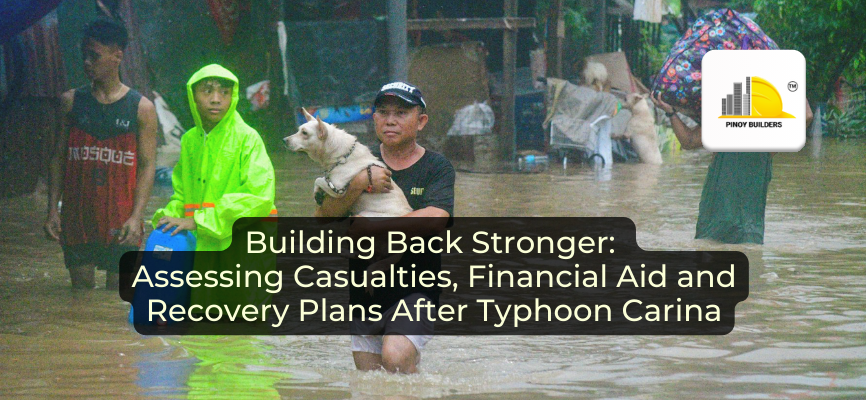On July 24, 2024, Typhoon Carina, also known as Super Typhoon Gaemi, intensified and brought heavy rains and massive flooding to the northern part of the Philippines. Despite the absence of a tropical cyclone wind signal (TCWS) in some areas, the southwest monsoon exacerbated the flooding, impacting coastal and low-lying regions. As the country grapples with the immediate aftermath, there is an ongoing assessment of casualties, available financial aid, and recovery plans to ensure a comprehensive and effective response.
In this article, we will examine the casualties and infrastructural damage caused by Typhoon Carina, as well as the existing and future flood control measures included in the government’s action plans. We will also share important information about the financial aid available to disaster-affected individuals, highlighting the importance of building back better for future resilience.

Casualties and Infrastructure: Immediate Effects of Typhoon Carina
Typhoon Carina left a significant human toll in its wake, with numerous injuries and fatalities reported. According to the situation briefing on Super Typhoon Gaemi held at Malacañang Park earlier today, 13 people have been declared dead due to the calamity, while 2 are injured and 2 others are still missing. This count may change as more information becomes available.
Due to the unprecedented disaster caused by major flooding in parts of NCR, 123,992 families are currently being assisted in and outside evacuation areas. In total, nearly a million people have been affected by the typhoon, with many from heavily impacted areas such as Quezon City, Valenzuela, and Malabon.
The destruction extended to critical infrastructure, including homes, roads, and public buildings, severely affecting the daily lives of residents. Essential services such as water, electricity, and communication were disrupted, compounding the difficulties faced by the affected communities.
Flood Control Plans and After-Effects of Typhoon Carina
Before Typhoon Carina struck, various flood control measures were in place to mitigate potential damage. For example, Marikina City Mayor Marcelino Teodoro noted in a Radyo 630 interview that the flooding caused by the southwest monsoon (or ‘habagat’) led to the highest number of evacuees since Tropical Storm Ondoy in 2009. Teodoro credited this to better preparation and the responsibility of Marikina City residents, who promptly followed evacuation guidelines when necessary.
“Ito po yung highest reported natin na evacuation na nangyari,” Teodoro said. “Baka bahagi na rin po ng kahandaan ng mga kababayan natin, ‘yung discipline nila sa paglikas. Nag-preemptive evacuation po ‘yung marami.”

Unfortunately, landslides and flooding were still not entirely avoidable. The aftereffects of the typhoon included the destruction of property due to flooding in vulnerable areas. Many families were still displaced from their communities. Additionally, there was an increased susceptibility to future natural disasters, such as continuous flooding in low-lying areas, landslides near mountains, and occasional high tides for those residing near water.
The government monitors major river basins like those in Pampanga, Agno, and Cagayan, along with the NCR/Pasig/Marikina/Laguna de Bay River basin—all of which have been crucial in informing residents prior to the rise of water levels. Notably, the Marikina River’s water level reached 20.6 meters on July 24, which prompted forced evacuations.
Actual Action Plan of the Government
The government’s response to Typhoon Carina involved immediate evacuation and rescue operations to safeguard lives.

- The Department of Social Welfare and Development (DSWD) reports that 360,228 food packs were released to those residing in areas that were devastated by the typhoon.
- The Office of Civil Defense (OCD) reports that 156 rescue calls were received on July 24, 2024, out of which 6 were successfully rescued around 10 PM that same day. The number rose to 30 as of the situation briefing.
- Department of the Interior and Local Government (DILG) highlights that NCR, Region III, and Region IV-A were the most affected, producing the most evacuees due to the calamity.
- NCR – 90,585 evacuees
- Region III – 39,639 evacuees
- Region IV-A – 17,938 evacuees
Short-term recovery initiatives included establishing temporary shelters and distributing relief goods to meet the urgent needs of the affected population. In the long term, the government plans to rebuild infrastructure, enhance disaster preparedness, and improve resilience against future calamities. These projects were highlighted during the President’s 3rd State of the Nation Address (SONA), during which he announced that 5,500 flood control projects had been completed and many other projects were being constructed across the country.
“Isa na rito ay ang Flood Risk Management Project sa Cagayan de Oro River, na magbibigay ng pangmatagalang proteksyon sa mahigit anim na raang ektarya ng lupa at animnapung libo nating mga kababayan. Isa pa ay ang proyekto sa Pampanga Bay na magsisilbing karagdagang lunas sa mga pagbabaha,” the President said.
Financial Aid: SSS Fund and Loans for Disaster-Affected People
The Social Security System (SSS) has stepped in to provide financial aid through calamity loans for members affected by Super Typhoon Carina. These loans are available to individuals in the National Capital Region and other areas declared under a state of calamity. Eligible members can apply for loans equivalent to one monthly salary credit or up to a maximum of PHP 20,000.
Here are the details:
- Eligibility Criteria:
- Must have a minimum of 36 monthly contributions.
- At least six contributions should be posted within the last 12 months.
- Must reside in the declared calamity area.
- Must be below 65 years old.
- No outstanding SSS short-term member loans or final benefit claims.
- Loan Details:
- Loan amount is equivalent to one monthly salary credit or up to a maximum of PHP 20,000.
- Application Process:
- Applications can be submitted online via the My.SSS account on www.sss.gov.ph.
- Approved loans will be disbursed to the member’s registered UMID-ATM card or a bank account with a PESONet-participating bank.
- Repayment Terms:
- Loan repayment period is two years (24 equal monthly installments).
- Annual interest rate is at 10%.
Building Back A Better Philippines
As of this writing, Super Typhoon Carina has weakened to a typhoon as it exits the Philippine Area of Responsibility (PAR) and heads toward Taiwan. The situation has not yet improved in many affected parts of the country, and the southwest monsoon is still expected to bring rain until Saturday, July 27.
In the wake of Typhoon Carina, assessing casualties, financial aid, and recovery plans are vital for rebuilding and strengthening community resilience. Comprehensive recovery plans, continuous support, and proactive measures are essential to mitigating the impact of future disasters. At the same time, community involvement remains key to ensuring a robust and effective response to natural calamities.
Typhoon Carina is only the third tropical cyclone to enter the PAR this year. In May, PAGASA predicted that 13 to 18 cyclones may enter the country’s territory in 2024. Increased vigilance is required from Filipinos, and immediate action to improve rescue operations and calamity preparedness is still very much needed from the government to prepare the country and build back a better and safer future for everyone.
References
ABSCBN. (n.d.). What does a state of calamity declaration mean for Metro Manila? ABSCBN. https://news.abs-cbn.com/news/2024/7/25/what-does-state-of-calamity-declaration-mean-for-metro-manila-926
GMA News. (n.d.). SSS: Calamity loans ready for Carina-hit members. GMA News. https://www.gmanetwork.com/news/money/companies/914605/sss-calamity-loans-carina-habagat/story/
GOVPH. (n.d.). Gov’t working to protect communities from La Niña — PBBM. GOVPH. https://pco.gov.ph/news_releases/govt-working-to-protect-communities-from-la-nina-pbbm/
Inquirer. (n.d.). Luzon folk flee as Carina triggers floods, and landslides. Inquirer. https://newsinfo.inquirer.net/1964490/luzon-folk-flee-as-carina-triggers-floods-landslides










